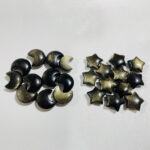Introduction
Raw calcite, a ubiquitous mineral prized for its versatility and aesthetic appeal, has been captivating humans for centuries. Its chemical composition, geological significance, and therapeutic properties have made it an indispensable resource across diverse civilizations and industries. This comprehensive article delves into the intricate world of raw calcite, exploring its origins, applications, and impact on our lives.

Origins and Distribution
Raw calcite belongs to the mineral group known as carbonates. It predominantly forms through the precipitation of calcium carbonate (CaCO3) from water sources, including marine environments and groundwater. Calcite is found in various geological formations, including limestone, chalk, and marble, making it widely accessible around the globe. Major calcite-producing countries include China, Italy, Spain, and the United States.
Physical Properties
Calcite is characterized by its trigonal crystal structure, which gives rise to its distinctive rhombohedral or scalenohedral shapes. It exhibits a hardness of 3 on the Mohs scale, making it relatively soft. Calcite typically possesses a translucent or opaque appearance and a vitreous to pearly luster. Its color can vary widely, ranging from colorless to white, yellow, green, and pink.
Chemical Properties
Raw calcite is primarily composed of calcium carbonate (CaCO3). However, trace elements and impurities can alter its chemical profile. For instance, iron impurities can impart a yellow or orange hue, while manganese can result in a pink coloration. Calcite dissolves in acidic solutions, releasing carbon dioxide (CO2) gas.
Classification and Varieties
The Gemological Institute of America (GIA) classifies calcite into three main varieties:
- Cleavage Calcite: Exhibits perfect rhombohedral cleavage and is commonly used in optical applications.
- Sparry Calcite: Characterized by large, transparent crystals that form in cavities and veins.
- Oolite Calcite: Consists of small, spherical calcite grains and is found in sedimentary deposits.
Applications of Raw Calcite
The multifaceted nature of raw calcite has led to its use in countless applications, including:
Industrial Uses
- Paper and Pulp Industry: Utilized as a filler and coating agent in paper manufacturing.
- Construction: Employed as a component in cement, plaster, and concrete.
- Agriculture: Applied as a soil amendment to neutralize acidity and improve soil structure.
- Pharmaceuticals: Used as a calcium supplement and an antacid.
Optical Applications
- Optical Instruments: Employed in prisms, lenses, and polarizing filters due to its birefringence.
- Jewelry: Cut and polished into gemstones for use in pendants, earrings, and rings.
- Art and Decorations: Incorporated into sculptures, figurines, and decorative objects.
Therapeutic Uses
- Crystal Healing: Believed to balance and energize the body and mind.
- Emotional Healing: Said to promote emotional stability and resilience.
- Physical Healing: Thought to alleviate physical symptoms such as indigestion, headaches, and joint pain.
Economic Significance of Raw Calcite
The global raw calcite market is valued at over US$ 10 billion, with an estimated annual production exceeding 250 million metric tons. China dominates the production and consumption of calcite, accounting for approximately 50% of the global market. The demand for calcite is projected to grow steadily in the coming years, driven by rising applications in construction, agriculture, and pharmaceuticals.
Impact on the Environment
Raw calcite plays a crucial role in the environment by acting as a carbon sink. It absorbs carbon dioxide from the atmosphere and stores it in marine and geological formations. This process contributes to mitigating climate change by reducing the concentration of greenhouse gases.
Therapeutic Properties: Scientific Evidence
While the therapeutic properties of raw calcite have been passed down through generations, scientific research provides mixed evidence to support these claims. Some studies suggest that calcite may have a calming effect on the nervous system, reduce inflammation, and promote bone health. However, more rigorous research is needed to fully understand the potential therapeutic benefits of raw calcite.
Tips and Tricks
- Cleaning Raw Calcite: Gently clean calcite with a soft brush or cloth and mild detergent. Avoid using harsh chemicals or abrasive materials.
- Charging Calcite: Expose calcite to sunlight or moonlight to energize it.
- Storing Calcite: Store calcite in a cool, dry place to prevent moisture damage.
- Meditation with Calcite: Hold calcite in the palm of your hand or place it on the third eye chakra during meditation to promote relaxation and inner peace.
Step-by-Step Approach
- Identify Calcite: Recognize the characteristic rhombohedral or scalenohedral shapes and the vitreous to pearly luster.
- Clean Calcite: Gently clean calcite with a soft brush or cloth to remove any impurities.
- Charge Calcite: Expose calcite to sunlight or moonlight for several hours to energize it.
- Use Calcite: Incorporate calcite into your daily life by carrying it, placing it in your home, or using it for therapeutic purposes.
Frequently Asked Questions (FAQs)
- What is the difference between calcite and marble? Marble is a metamorphic rock primarily composed of calcite. It is recrystallized calcite with a distinct crystalline structure and a wider range of colors and patterns.
- Is calcite a crystal? Yes, calcite is a crystalline mineral with a trigonal crystal structure. It forms well-defined crystals with specific geometrical shapes.
- Can calcite scratch glass? No, calcite cannot scratch glass. Glass has a hardness of 5.5 on the Mohs scale, while calcite has a hardness of 3.
- Is calcite radioactive? No, calcite is not radioactive. It does not contain any significant amounts of radioactive elements.
- What is a possible new app for calcite products which combines energy with aesthetics? Calcite-infused architectural panels can absorb carbon dioxide from the atmosphere while providing a decorative and energy-efficient building material.
-
What is a table showing the estimated calcite reserves by country?
| Country | Estimated Reserves (million metric tons) |
|—|—|
| China | 120 |
| Italy | 30 |
| Spain | 20 |
| United States | 15 |
| Mexico | 10 | -
What is a table showing the physical properties of calcite compared to other minerals?
| Property | Calcite | Quartz | Feldspar |
|—|—|—|—|
| Hardness (Mohs scale) | 3 | 7 | 6 |
| Cleavage | Perfect rhombohedral | Conchoidal | Perfect basal |
| Luster | Vitreous to pearly | Vitreous | Vitreous to greasy |
| Specific Gravity | 2.71 | 2.65 | 2.56 | -
What is a table showing the different types of calcite and their uses?
| Type | Uses |
|—|—|
| Cleavage Calcite | Optical prisms, lenses, polarizing filters |
| Sparry Calcite | Jewelry, figurines, decorative objects |
| Oolite Calcite | Soil amendment, fertilizer |
| Travertine | Building material, flooring, tiles |
| Marble | Building material, sculptures, countertops | -
What is a table showing the therapeutic uses of calcite and their potential benefits?
| Therapeutic Use | Potential Benefits |
|—|—|
| Emotional healing | Promotes emotional stability and resilience |
| Physical healing | May alleviate physical symptoms such as indigestion, headaches, and joint pain |
| Crystal healing | Believed to balance and energize the body and mind |
| Meditation | May promote relaxation and inner peace | -
What is a table showing the calcite production by country?
| Country | Production (million metric tons) |
|—|—|
| China | 125 |
| Italy | 25 |
| Spain | 20 |
| India | 15 |
| United States | 10 |




























